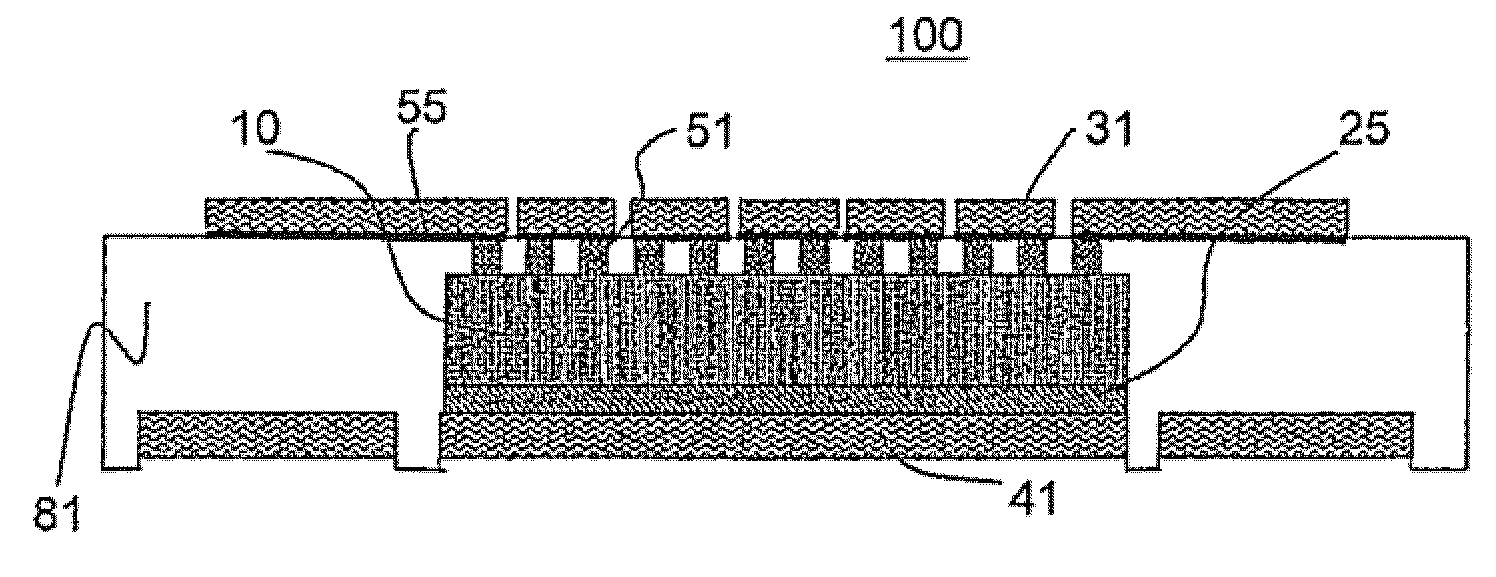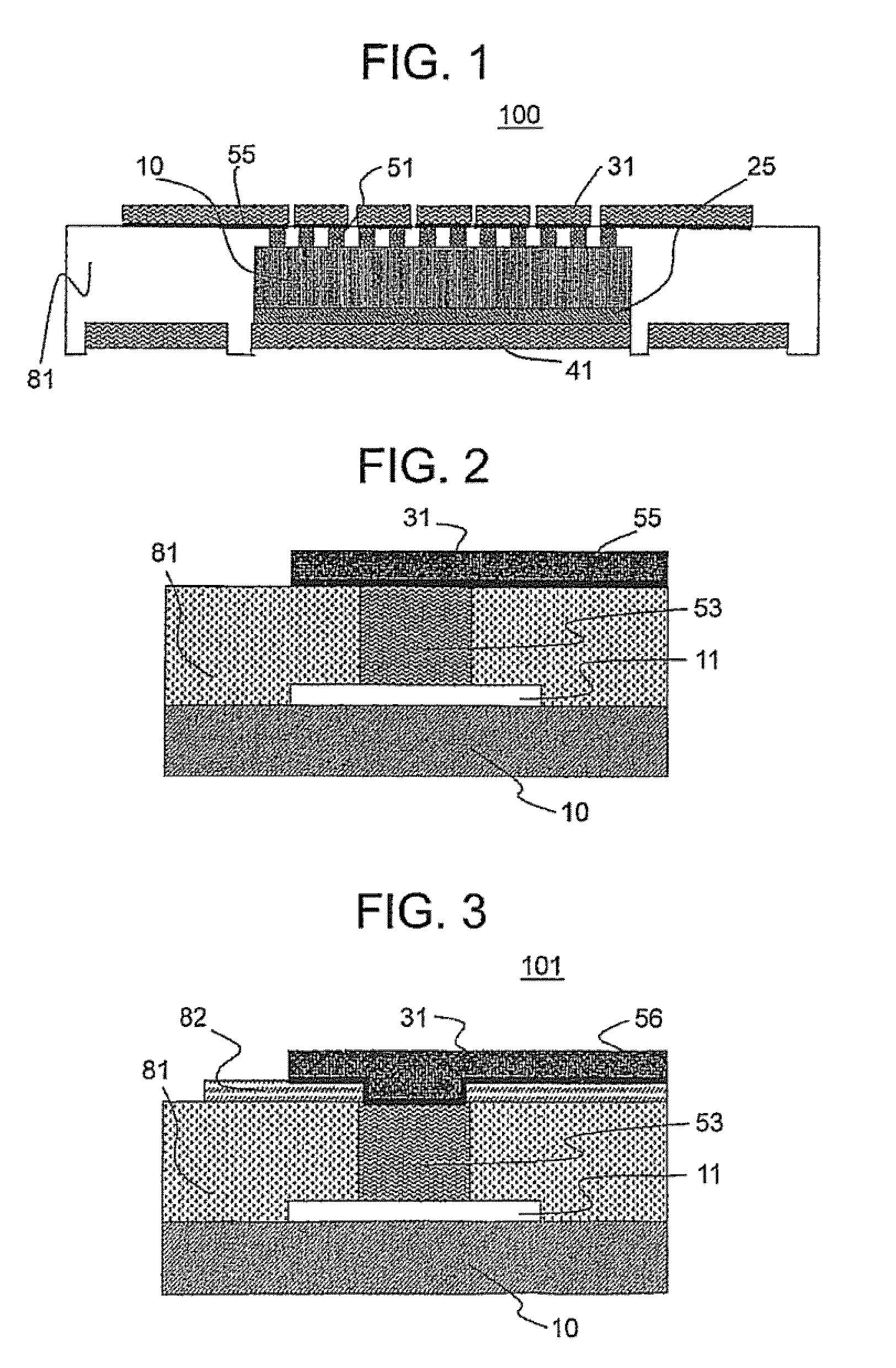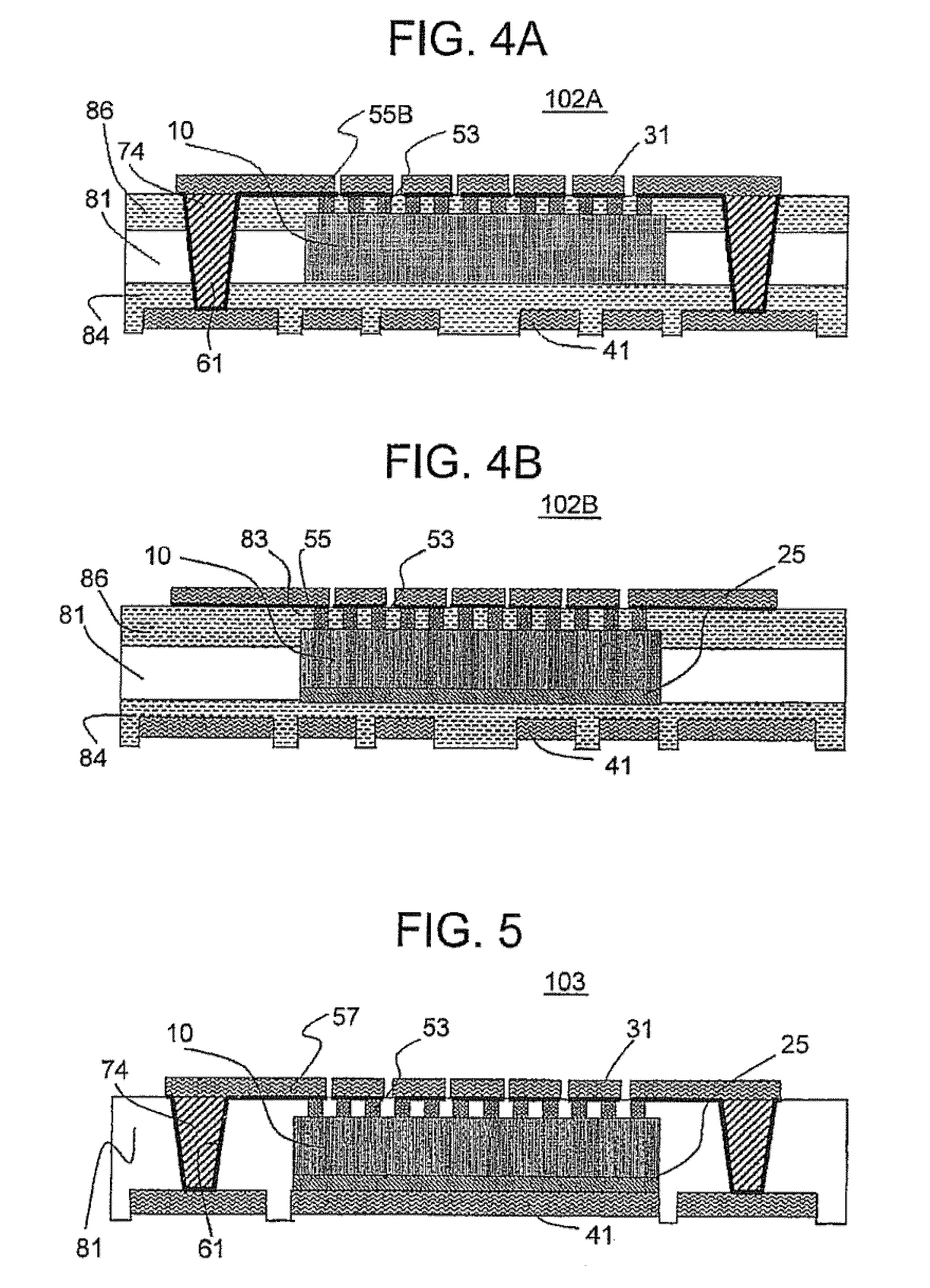In the case of using the photosensitive resin, inclusion of silica fillers or glass cloth causes a loss of resolution whereby a sufficient amount of resin for maintaining the strength reliability cannot be used, to thereby incur a problem in that reliability as the
package is lost.
In addition, since the build-up wiring is formed only on the surface of the
semiconductor device including the electrode terminals, the conductive-wiring
layers are only formed on the one side to cause an inconvenience that it cannot be used as the circuit board other than the
package.
Furthermore, there occurs a deviation upon bonding together the mold substrate and the protruding electrodes, to thereby cause a risk that an opening area above the protruding electrodes is narrower, and incur a problem in that the wettability of the solder balls is degraded.
The protruding electrodes, which are formed only on the side of electrode terminals of the
semiconductor device, do not have a function of interconnections, thereby causing an inconvenience that it cannot be used as the circuit board.
Furthermore, since the
semiconductor device is connected by an ordinary flip-
chip bonding after forming the conductive-wiring layer of the circuit board, manufacture of the circuit board as well as mounting of the semiconductor device is costly similarly to an ordinary case, whereby a cost reduction cannot be expected.
In this case, the configuration wherein the boards including the cavity and semiconductors are alternately stacked one on another causes a problem in that an organic resin layer having little rigidity is formed on both the top and bottom of the semiconductor device, whereby fragile semiconductor
silicon or GaAs is split at once by application of a pressure thereto.
The resin layer on which the
chip is mounted is subjected to formation of interconnections while using a
copper sheet affixed onto one side thereof, whereby the interconnections are formed by an
etching to cause a problem in that narrow-
pitch wiring cannot be provided within the package, unlike the case of a semi-additive technique.
Due to the configuration wherein the semiconductor device is connected by a flip-chip bonding, manufacture of the circuit board and mounting the semiconductor is costly as in an ordinary case, whereby a problem occurs that cost reduction cannot be expected.
In this case, since the interconnections cannot be spread to excess the size of the semiconductor, and the structure is such that the conductive-wiring layer is exposed only on one side of the package board, there is a defect that it is only used as a package, and cannot be used as a circuit board.
In addition, the
interconnection distance with respect to the other electronic parts is extremely long due to the connection via a mother board in a
surface mounting, thereby incurring a problem in that a high-speed electric performance cannot be obtained as a product, although the high-speed electric performance is excellent only within the package.
Since a portion of organic resin is only the element located right under the location of through-holes of the core board on which the
semiconductor chip is to be mounted, there is a problem in that the
semiconductor chip may be split due to a pressure applied during mounting the semiconductor chip because of the
bending moment being applied onto the soft resin if a thin chip that is thinner than around 100 μm is used.
In addition, if the via-holes am formed in the resin core board embedding therein a semiconductor chip by using a
drill etc., there occurs a problem in that a muss is applied onto the semiconductor chip embedded in the vicinity of the via-holes to split the chip due to an insufficient rigidity of the resin during the drilling process.
Thus, the via-holes must be significantly apart from the embedded semiconductor chip, thereby increasing the outer size of the board.
The product wherein the semiconductor chip is mounted on a
metal or
ceramic heat sink in a face-up structure and conductive-wiring
layers are stacked on the electrode terminals has a drawback that the conductive-wiring layers are formed only on one side thereof, conductive-wiring layers are not provided on the side near the
heat sink, and thus cannot be used as the circuit board.
Thus, there is a problem in that the process cannot reduce the cost.
In addition, due to use of the flip-chip technique, it is needed to apply a
heat stress onto the dielectric film at a high temperature of around 300° for about 30 seconds during bonding the bump onto the conductive wiring on the supporting substrate if the Au stud bumps are used, thereby causing degradation of resin and the problem of decrease in the reliability of products.
If solder is used for the bumps, the bonding portion itself has the problem in
heat resistance, thereby causing the problem of breakage of bump-bonded portion in the semiconductor-chip-embedded board, due to a reflow treatment during the
surface mounting, thereby causing a lower reliability of products.
On the surface of the semiconductor chip opposing the supporting substrate, the conductive wiring is not flat, thereby incurring a defect that the later mounting process using the semiconductor-chip-embedded board proves a poor workability.
However, if the positioning pattern is larger than the size of the mounted chip, the chip moves after the mounting, thereby causing the problem of deviation of the chip-mounted position.
If the positioning pattern is equivalent to the
chip size, the chip may collide with the positioning pattern during mounting the chip by using a mounting device, to incur split of the chip and thus decrease the reliability of products.
Thus, there is the problem of deviation occurring in the positional relationship between the vias positioned on the side surface of chip and the electrode terminals of chip.
After removing the transfer substrate, the bottom surface of chip is exposed, whereby there is a risk that the bending or collision that occurs in the later process may split the chip, thereby causing the problem in the reliability and yield of products.
On the surface through which the surface of IC chip is exposed, the surface of wiring pattern is flush with the resin layer on the side surface thereof, whereby there occurs a short-
circuit failure in the wiring during the solder bonding if the solder
resist layer is not provided.
Thus, an
internal stress occurring in the thickness direction of the board, with the embedded portion of chip being the center, causes the problem of peel-off between the vias and the dielectric resin.
The circuit board described in JP-2006-19342A has the problem that a mounting process using the conductive wiring formed on both the surfaces cannot be performed because a
metal shield layer and a magnetic-body shield layer are formed on one of the surfaces of the IC-chip-embedded board.
In addition, since the entire surface opposing the electrode terminals of IC chip directly contacts a mound pattern layer, the chip is warped by the difference in the
thermal coefficient of expansion between the Si chip and the metal configuring the ground, thereby causing split of the chip if the chip is thin.
However, since vias cannot be provided in the vicinity of chips, the
line length is increased to thereby cause the problem in the high-speed electric performance.
In the above conventional circuit boards, there are problems as recited hereinafter.
The problems are such that when a functional device is to be embedded and if the circuit board including an organic resin as a base material and having no supporting substrate is used to underlie the mounting surface of the functional device, the portion of the organic resin of the circuit board is inflected due to the mounting load, thereby generating a bending stress on the functional device itself to damage the device if the functional device itself is comprised of
silicon,
ceramic etc.
 Login to View More
Login to View More 


